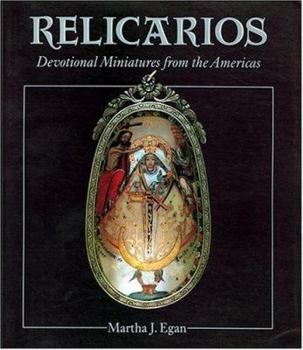Relicarios: Devotional Miniatures from the Americas
Select Format
Select Condition 
Book Overview
The relicario is the Latin American version of the reliquary locket, a small, finely wrought devotional pendant used to contain relics and mementos of the saints.Martha Egan, renowned authority on... This description may be from another edition of this product.
Format:Paperback
Language:English
ISBN:0890132542
ISBN13:9780890132548
Release Date:January 1996
Publisher:Museum of New Mexico Press
Length:130 Pages
Weight:1.10 lbs.
Dimensions:0.6" x 8.1" x 9.3"
Customer Reviews
1 rating
Relicarios: Devotional Miniatures from the Americas
Published by Thriftbooks.com User , 24 years ago
Author Martha Egan has a shop called Pachamama in Santa Fe, New Mexico. There she sells antique and traditional folk art from Latin America. Her studies of Latin American folk art have led her to write this book. She has also written a book about milagros and a novel about art brokering and smuggling. She is currently working on a book about Latin American jewelry.On 13 Feb 2000, I attended her lecture at the San Antonio Museum of Art where Martha has her private collection of relicarios on loan for exhibit. I encourage you to see this exhibit while it is at SAMOA.Relicarios are devotional miniature pendants or lockets. They sometimes contain bits of bone, tooth, or cloth, reputedly from a saint. Many have survived from the conquest because they were treasured by families or the church. They are often elaborate and finely crafted. Materials used to make relicarios include wood, metal, bone, ivory, and shell.Relicarios were worn suspended around the neck from a chain or cord. Some are displayed on walls or hung onto church sculptures of saints to honor an answered prayer. Relicarios are still used today as a talisman to "inspire, comfort, and protect the bearer from harm."A miniature painting or sculpture of a saint is sometimes protected by glass on a relicario. Some relicarios are two-sided works of art. For this reason, SAMOA displays some relicarios so thay can be viewed from both sides.In her book, Martha describes the ancient origins of relicarios from Greek and Roman times in which "the physical remains of gods or heroes were thought to have magical properties, and possession of such treasures conferred religious and political status upon the owner." Encolpium contained a bit of cloth dipped in the oil from lamps burned in front of saints' sarcophagi. The cloth could also have been dipped in a martyr's blood, or could have come from clothing worn by a saint.As with anything of value, authenticity of relics is questionable. Martha cites "no fewer than a dozen heads and sixty fingers of Saint John the Baptist (this is spite of the alleged burning of his corpse by Emperor Julian in the fourth century); seven foreskins from the infant Jesus; fifteen arms of Saint James; thirty bodies of Saint George; and six breasts of Saint Agatha." When Saint Elisabeth of Thuringia was buried, her body was quickly torn apart by devotees. John Calvin asked for an end to all this relic madness in 1543.Martha's book is an interesting read.





